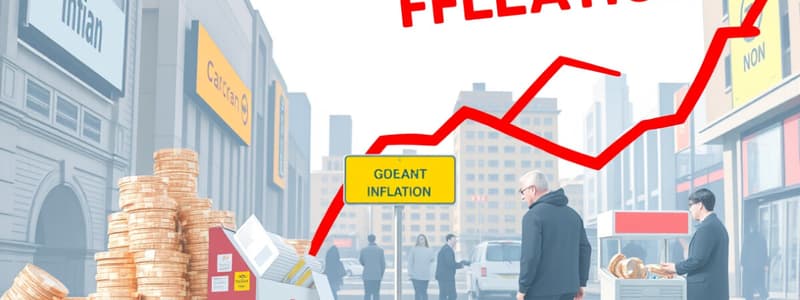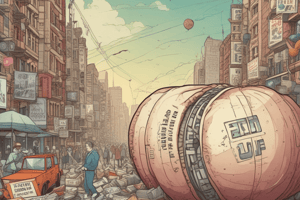Podcast
Questions and Answers
Which is the best definition of inflation?
Which is the best definition of inflation?
- An increase in the rate of unemployment.
- A sudden drop in the price of goods and services.
- A decrease in overall production costs.
- A gradual expansion in the price of goods and services. (correct)
Which scenario is an example of cost-push inflation?
Which scenario is an example of cost-push inflation?
An increase in workers' wages raises the production cost of cars, and car prices as a result.
When government intervention makes currency worthless, this condition is called?
When government intervention makes currency worthless, this condition is called?
Hyperinflation
What rate does the equation calculate?
What rate does the equation calculate?
Stagflation occurs when high inflation combines with?
Stagflation occurs when high inflation combines with?
Which scenario is an example of demand-pull inflation?
Which scenario is an example of demand-pull inflation?
Typically, low inflation is a sign of?
Typically, low inflation is a sign of?
According to the graph, 1971 to 1976 was a period of stagflation due to?
According to the graph, 1971 to 1976 was a period of stagflation due to?
What is one consequence of stagflation?
What is one consequence of stagflation?
Typically high inflation is a sign of?
Typically high inflation is a sign of?
Flashcards are hidden until you start studying
Study Notes
Inflation Basics
- Inflation is defined as a gradual increase in the prices of goods and services.
- A healthy economy typically experiences low inflation, which indicates a steady rise in demand.
Types of Inflation
- Cost-push Inflation: Occurs when production costs increase, leading to higher prices. Example: An increase in workers' wages raises car production costs, making car prices rise.
- Demand-pull Inflation: Happens when consumer demand exceeds supply. Example: Consumers having more disposable income to purchase cars leads to increased prices.
Stagflation
- Stagflation is characterized by high inflation, high unemployment, and low production levels.
- A significant consequence of stagflation is a drastic slowdown in the economy as money loses its purchasing power.
- Case study: The period from 1971 to 1976 is notable for stagflation, attributed to rising unemployment combined with inflation.
Hyperinflation
- Hyperinflation occurs when government intervention renders currency worthless, causing extreme and rapid price increases.
Inflation Rate
- The inflation rate is a key economic indicator calculated using specific equations to assess price changes over time.
Economic Implications
- High inflation usually signals a struggling economy due to rising production costs affecting suppliers.
- Monitoring inflation types and rates is crucial for understanding economic health and consumer behavior.
Studying That Suits You
Use AI to generate personalized quizzes and flashcards to suit your learning preferences.




